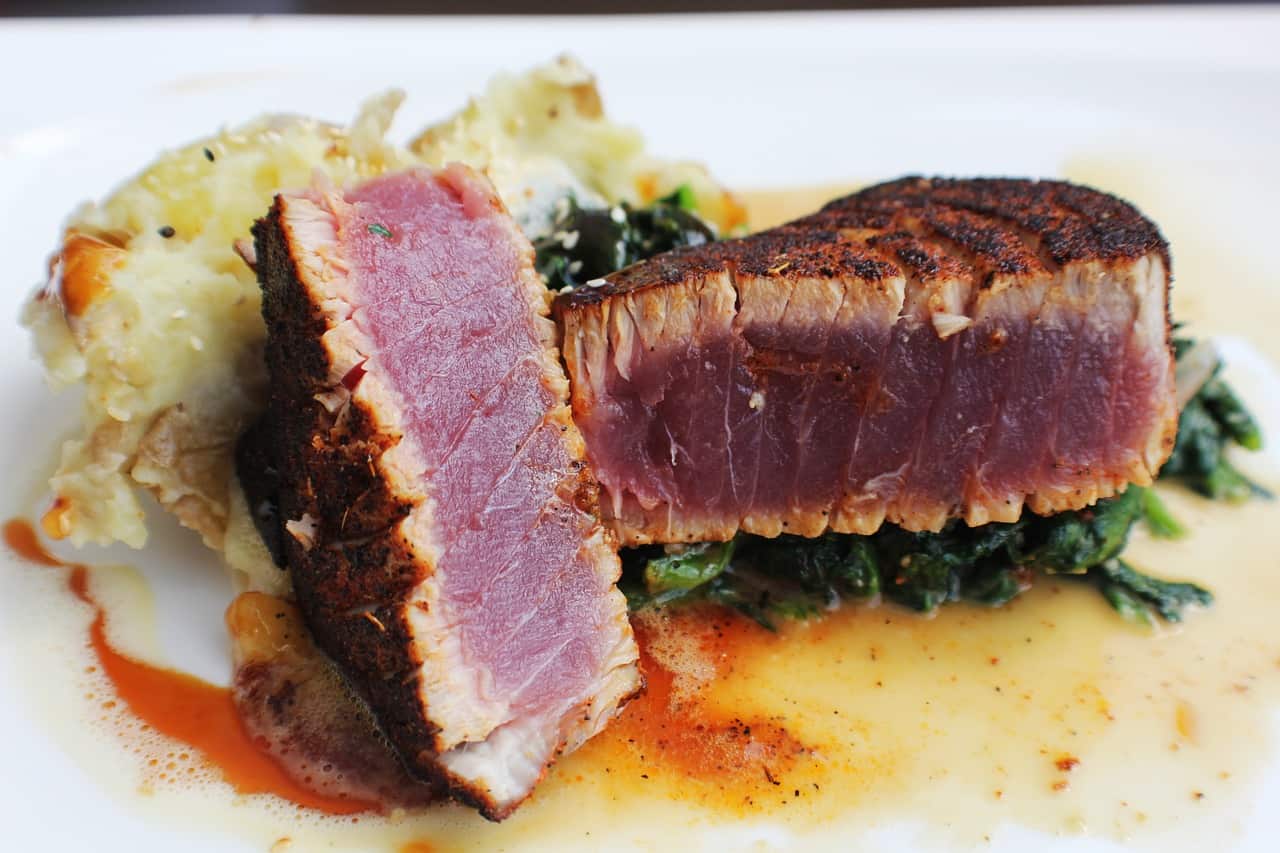A la Rose is a term used to describe fish that is prepared from rare to medium-rare. There are some types of fish that should preferably be eaten well done, as undercooked fish can be harmful to health.
So can you eat fish medium-rare:
Denser fish like salmon and tuna can be eaten raw and taste delicious when prepared from rare to medium rare. Tilapia may also be eaten medium-rare. However, delicate fish such as pollock, sea bass, and haddock should be eaten medium to well done.
The Food and Drug Administration (FDA) recommends cooking fish at 145°F.
| Wondering about what meat you can serve medium-rare and why? I was wondering the same thing! That is why I created a complete list of all the meat you can eat medium-rare. Here it is! |
Can you eat salmon medium-rare
Most cooks agree that the best temperature for salmon is between medium-rare, 110°F to 125°F (43°C – 51°C), and medium 125°F to 140°F (51°C – 60°C). Searing salmon to this temperature gives it a flaky crust while keeping it moist in the center, resulting in the best flavor. So, the answer is yes, you can eat salmon medium-rare.
This temperature gives the salmon a flaky crust while keeping it moist in the center for the best flavor.
The flavor and texture of salmon vary by species, preparation method, season, and farming method, but generally, all salmon have a high-fat content and a rich oily texture. Salmon can be eaten raw or cooked.
To avoid viral or bacterial contamination, handle salmon carefully and do not leave it exposed for an extended period of time before serving. Proper food safety precautions must be taken to prevent foodborne illness. Salmon is best cooked on a grill skin side down.
Can you eat frozen salmon medium-rare
Yes you can eat frozen salmon done medium rare because salmon does not need to be thawed before cooking. Once you put it in the pan, the same temperatures apply as explained above.
Frozen salmon has the same nutritional value as unfrozen salmon. None of the nutrients are lost when frozen. Salmon is safe to eat if it is prepared properly after freezing. In fact, freezing salmon before eating it is a good way to ensure that any bacteria that may be in the fish is eliminated.
There are two signs that your previously frozen salmon is safe to eat:
- The salmon does not have a “fishy” smell.
- Press into the flesh of the salmon. The flesh should bulge at first, but then immediately return to its original shape.
Can you eat Tuna medium-rare
The key to a perfectly seared piece of tuna is that it should be cooked rare to medium-rare. Tuna is a meaty fish. It has a similar texture to chicken. Since it is a carnivore fish, it has a salty taste and smells and tastes less like fish.
When you prepare tuna steaks, you should sear them over high heat until they are medium-rare. This should be done on a grill. Tuna steaks can easily become dry and tough if overcooked. Therefore, the center should preferably still be pink when they are done.
Yellow Tale and Ahi tuna are similar, except that Yellow Tale tuna is larger and has a reddish flesh color, while Ahi tuna is smaller and has a pinkish flesh color.
Below are the recommended cooking temperatures for tuna:
- Rare: 120 °F – 130 °F.
- Medium Rare: 130 °F – 140 °F (54°C – 60°C).
- Medium: 140 °F – 150 °F (The recommended USDA temperature is 145 °F)
- Well: over 150 °F (Not recommended)
Can you eat frozen tuna medium-rare
Tuna, like salmon, does not lose its flavor or texture when frozen. It is generally safe to eat medium-rare tuna if it has been frozen. Freezing tuna kills all parasites and meets Food and Drug Administration (FDA) guidelines.
Always buy the fish from a reputable fishmonger who is clear about the source of their fish and how it has been treated. The FDA advises letting the tuna steak thaw overnight in the refrigerator before you prepare it. This is because tuna cooks very quickly and can dry out very quickly when cooked.
Can you eat seabass medium-rare
Fattier fish tend to cook more slowly than lean fish. Sea bass is a white fish with a mild, delicate flavor and a subtle sweetness reminiscent of cod or grouper. Its flesh can be described as tender, moist and buttery. Sea bass has firm, medium-sized flakes, similar to haddock.
Sea bass is considered a delicate fish and is, therefore, best cooked all the way through. It is perfect for those with sensitive palates. Sea bass is a saltwater fish and saltwater kills bacteria. Keep sea bass frozen to prevent new bacteria from forming.
According to USDA recommendations, sea bass is done when it reaches an internal temperature of 145 °F (60°C). When properly prepared, it should flake easily with a fork, at the thickest part. So the best temperature for sea bass is medium to medium-well.
Can you eat Tilapia medium-rare
Tilapia has a medium-firm, flaky texture, lean meat, and a sweet and mild flavor. Some may even claim Tilapia is tasteless. When raw, it is slightly translucent and sometimes has a white or pink color. Tilapia’s color changes to white and opaque when it is fully cooked. Its mildly sweet flavor is similar to red snapper or striped bass.
The FDA has approved tilapia as one of the best fish for children, pregnant women, and nursing mothers and it is considered a very healthy eating fish.
The ideal cooking temperature for Tilapia is between 140°F – 145°F (60°C – 62°C). This means that the best temperature for Tilapia is medium to well done. Tilapia should not be eaten medium-rare.
Can you eat Halibut medium-rare
Halibut has a firm yet tender texture. It is a lean fish with mild, sweet-tasting white flesh and has large flakes. It has a similar taste to tilapia. Because of its mild flavor, halibut is a fish that pairs well with strong seasonings such as pesto, basil, or lemon juice. Halibut has a low fat content, so it can overcook and become dry very quickly.
Halibut’s fat content is lower than other fish. This makes it somewhat difficult to prepare. While the FDA recommends cooking the fish to an internal temperature of 145 °F (62°C), this can dry out the halibut.
You can get excellent results by cooking halibut to an internal temperature between 125 °F and 135 °F (51°C – 57°C).
Halibut is best when cooked at a low internal temperature and begins to break down at about 118 °F (47°C). Use a digital meat thermometer to get accurate results. The perfect temperature for halibut is medium-rare.
It is possible to eat medium rare halibut meat (ceviche) if it has been previously frozen for about four to six days and then thawed in the refrigerator.
Can you eat swordfish medium-rare
Swordfish has a high-fat content. It has a slightly sweet taste, and its texture is moist and meaty. The flesh of this fish ranges from white/ivory to pink/orange. Swordfish is an oily and rich-tasting fish and is sold exclusively as steak.
It is not recommended to eat swordfish medium-rare, as undercooked swordfish meat can become rubbery.
While not recommended, it is possible to eat medium rare swordfish.
The ideal cooking temperature for swordfish is medium to medium-well, but some people, and even some chefs, consider this temperature a bit overcooked, aiming for an internal temperature of 130 °F (54°C).
Keep in mind that the internal temperature of the swordfish will continue to rise as it rests. Grilling or barbecuing is the best cooking method as it brings out the most flavor.
Can you eat Trout medium-rare
Trout is noted for its delicate and mild flavor—the more tender the fish, the finer the flake. There are several sizes and types of trout, but the rainbow trout is the most popular trout species in North America.
It is primarily a freshwater fish and has a relatively mild flavor. Depending on where the trout are raised, it may have a muddy taste.
The skin of the rainbow trout is dark, slippery, and shiny. Rainbow trout also have a slightly nutty taste.
The flesh of the trout has some similarities to that of salmon. It is recommended that trout be cooked to an internal temperature of 145 °F, which means it is best served medium to medium-well. It is not advisable to eat trout raw or medium-rare.
Can you eat Mahi medium-rare
Mahi has a very distinctive, moderately mild, and sweet flavor. The texture of this fish is moderately firm with large, moist flakes. Mahi also has a thick skin that must be removed before cooking the fish.
Mahi has a similar texture to swordfish and halibut. However, Mahi is not as steak-like as the previously mentioned fish. It is more similar to swordfish but has a much milder flavor. However, compared to other fish, such as cod, Mahi has a more distinct flavor.
It contains very little fat. Mahi should be cooked to an internal temperature of 137 °F (58°C).This means that the ideal temperature for cooking mahi-mahi is medium-rare but no more than medium. Due to its low-fat content, Mahi will quickly dry out when overcooked.
Conclusion
There are many factors involved in determining the proper cooking temperature for fish. From density to flakiness, freshwater or wild fish, time of year, type of fish, etc. However, as a rule of thumb, denser fish can be cooked medium-rare, while more tender fish tastes better and is healthier cooked all the way through. However, the FDA advises that the minimum internal temperature of fish should be 145 °F (62°C).

